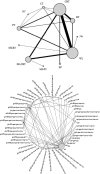Dismantling cognitive-behaviour therapy for panic disorder: a systematic review and component network meta-analysis
- PMID: 29368665
- PMCID: PMC6137372
- DOI: 10.1017/S0033291717003919
Dismantling cognitive-behaviour therapy for panic disorder: a systematic review and component network meta-analysis
Abstract
Cognitive-behaviour therapy (CBT) for panic disorder may consist of different combinations of several therapeutic components such as relaxation, breathing retraining, cognitive restructuring, interoceptive exposure and/or in vivo exposure. It is therefore important both theoretically and clinically to examine whether specific components of CBT or their combinations are superior to others in the treatment of panic disorder. Component network meta-analysis (NMA) is an extension of standard NMA that can be used to disentangle the treatment effects of different components included in composite interventions. We searched MEDLINE, EMBASE, PsycINFO and Cochrane Central, with supplementary searches of reference lists and clinical trial registries, for all randomized controlled trials comparing different CBT-based psychological therapies for panic disorder with each other or with control interventions. We applied component NMA to disentangle the treatment effects of different components included in these interventions. After reviewing 2526 references, we included 72 studies with 4064 participants. Interoceptive exposure and face-to-face setting were associated with better treatment efficacy and acceptability. Muscle relaxation and virtual-reality exposure were associated with significantly lower efficacy. Components such as breathing retraining and in vivo exposure appeared to improve treatment acceptability while having small effects on efficacy. The comparison of the most v. the least efficacious combination, both of which may be provided as 'evidence-based CBT,' yielded an odds ratio for the remission of 7.69 (95% credible interval: 1.75 to 33.33). Effective CBT packages for panic disorder would include face-to-face and interoceptive exposure components, while excluding muscle relaxation and virtual-reality exposure.
Keywords: Cognitive-behaviour therapy; component network meta-analysis; panic disorders.
Figures
References
-
- American Psychiatric Association (1998) Practice guideline for the treatment of patients with panic disorder. Work group on panic disorder. American Journal of Psychiatry 155, 1–34. - PubMed
-
- American Psychiatric Association (2013) Diagnostic and Statistical Manual of Mental Disorders, 5th edn Arlington, VA: American Psychiatric Association.
-
- Barlow DH and Craske MG (2000) Mastery of Your Anxiety and Panic: MAP-3. New York: Graywind Publications.
-
- Berger T, Boettcher J and Caspar F (2014) Internet-based guided self-help for several anxiety disorders: a randomized controlled trial comparing a tailored with a standardized disorder-specific approach. Psychotherapy (Chic) 51, 207–219. - PubMed
-
- Bernstein DA and Borkovec TD (1973) Progressive Relaxation Training: A Manual for the Helping Professions. Champaign, IL: Research Press.
Publication types
MeSH terms
LinkOut - more resources
Full Text Sources
Other Literature Sources
Medical


